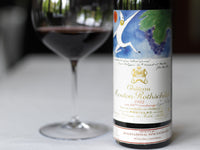
Chateau Margaux’s history and renown stem equally from the intrinsic genius of the place as from the contributions made by the various people who have served it for five centuries. But there has probably not been an owner who has played such a decisive role, in such a short time, as André Mentzelopoulos, who purchased the Estate in 1977 and who would have been 100 years old today.
It was the Marquis de la Colonilla who, 200 years ago, left his own mark on the Estate, in honour of the wine, through the construction of this great architectural heritage in a style inspired by ancient Greece; the architect Louis Combes had designed the Château’s peristyle paying homage to the Parthenon. André Mentzelopoulos was filled with pride and happiness at the sight of these Ionic columns that reminded him of his native Greece. More than 160 years later he had the foresight to take the radical measures necessary, in barely three years, to give back to Château Margaux, the lustre that it had lost during the long Bordeaux wine crisis.

The vineyards of Chateau Margaux were fully developed in the 1600’s by the d’Auledes family. By the end of the 17th century, the estate of Chateau Margaux grew to 265 hectares. One third of that acreage was cultivated for grapes to produce wine.
Unlike many properties, the vineyards of Chateau Margaux have remained relatively unchanged for centuries. To illustrate that point, by 1680, the vineyards consisted of 75 hectares of vines. Today, 350 years later, the vineyards are almost the same size with 80 planted hectares of vines, just like it was in 1700.
Most Common Varietal Blend of Chateau Pouget Margaux
- 60% Cabernet Sauvignon
- 30% Merlot
- 10% Cabernet Franc
Due to the amazing quality of the wine, the estate took the name of the appellation. Even today, the only Bordeaux wine to bear the name of the appellation from where it resides remains Chateau Margaux.
Food Pairings And Serving
Traditionally the great Bordeaux wines are served “chambrés”, that is to say at an ambient temperature about 18-19°C (64-66 °F). Above that temperature, the nose loses some finesse and the alcohol overpowers the delicate aromas of the bouquet; even in the fruit in young wines the tannins appear to be drier and less fleshy. When the temperature is too low, the aromas have difficulty in coming out and the wine seems dull and shorter. The same principles apply to the Pavillon Blanc; however, the temperature threshold is lower and it should be served at between 10 and 13°C (50 and 55°F) depending on the room temperature.
It is best paired with all types of classic meat dishes, veal, pork, beef, lamb, duck, game, roast chicken, roasted, braised and grilled dishes. Chateau Margaux is also good when matched with Asian dishes, rich fish courses like tuna, mushrooms and pasta. While the white wine of Chateau Margaux, Pavillon Blanc can be paired perfectly with all types of seafood, shellfish, sushi, sashmi, veal, chicken, pork and cheeses.
Tasting Notes
Dark ruby in color, the wine is silky and seductive. This is not a powerful wine, instead a velvet and satin texture with complexity and length. On the palate, the wine beguiles you with its sweetness, lift and sumptuous qualities. This vintage contains a record amount of tannins for the estate yet these tannins are so ripe and soft, you’ll barely notice them. This gem will have the ability to age for several decades.
Tasting is rarely a solitary exercise as it often demands opinions to be expressed in a particular language that doesn’t need to be mysterious.
Big Hammer Wines
The wine experts at Big Hammer Wines taste thousands of wines every year from around the globe, looking for quality and value. This special offer reflects the passion we have for our clients.
Discover the world through its wines, ClickHere! Visit Bighammerwines.com and become a wine expert!


